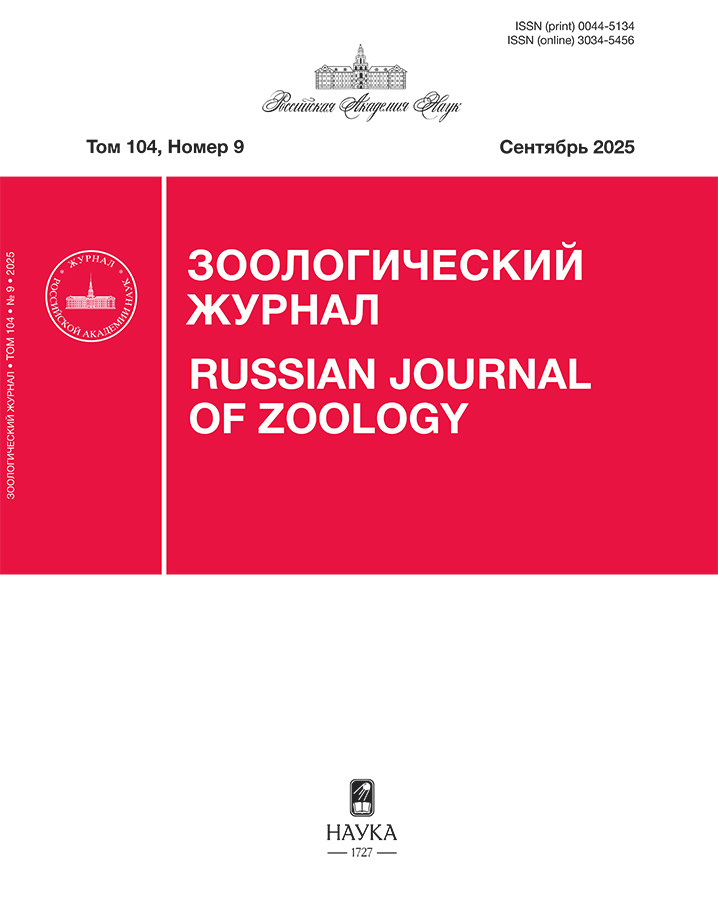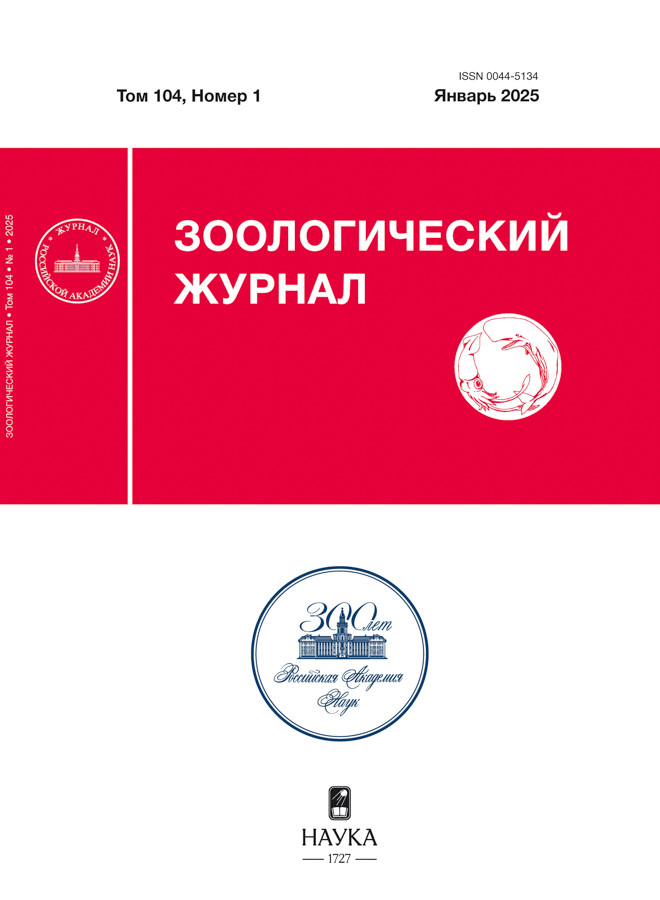Том 104, № 1 (2025)
Статьи
Новые фаунистические и таксономические данные по панцирным клещам (Acari, Oribatida) Гватемалы
Аннотация
Исследование базируется на орибатологических материалах, собранных в четырех локациях Гватемалы. Представлен перечень из 48 видов, относящихся к 38 родам и 28 семействам; из них 39 видов, 26 родов и 13 семейств отмечены для Гватемалы впервые, а два вида, один род и одно семейство отмечены для Неотропической области впервые. Описаны три новых вида: Hermanniella oblonga Ermilov sp. n. (Hermanniellidae), Protoribates silvaticus Ermilov sp. n. (Haplozetidae) и Pergalumna guatemalaensis Ermilov sp. n. (Galumnidae).
 3-15
3-15


Описание Candona fuscorara sp. n. с данными по 18S рРНК и переописание Candona uschunica Mazepova 1990 (Ostracoda, Podocopida, Candonidae) из озера Байкал
Аннотация
Приведено иллюстрированное описание самок и самцов Candona fuscorara Alekseeva et Krivorotkin sp. n. По строению раковины и конечностей особи нового вида наиболее близки к Candona uschunica Mazepova 1990. C. uschunica является редким и слабоизученным видом, его оригинальное описание кратко и неполно. На основе типового материала из спиртовой коллекции Г. Ф. Мазеповой (синтипы) подготовлено переописание самок и самцов C. uschunica, с целью сохранности коллекции особи высушены, из их числа выделены лектотип и паралектотипы. С использованием светового и сканирующего электронного микроскопов подробно изучена морфология раковин обоих видов, приведено иллюстрированное описание конечностей, в том числе ротовых придатков; представлено подробное сравнение, кратко охарактеризована экология. Получены данные о последовательности гена 18S рРНК для нового вида.
 16-39
16-39


Оценка влияния инвазии самшитовой огнёвки (Cydalima perspectalis, Lepidoptera, Crambidae) на фауну двупарноногих многоножек (Diplopoda) Кавказского биосферного заповедника
Аннотация
Исследованы изменения видового состава и численности диплопод на участке самшитника тисо-самшитовой рощи, возникшие в результате инвазии самшитовой огневки. Выявлено исчезновение или сокращение численности ряда видов, смена доминантов и субдоминантов на исследуемой площадке. Показаны статистически значимые снижение альфа-разнообразия по индексу Шеннона, изменение бета-разнообразия и обилия отдельных видов.
 40-51
40-51


Биоразнообразие офиур (Echinodermata, Ophiuroidea) морей России
Аннотация
На основе литературных и собственных данных проведен сравнительный анализ фаун офиур (змеехвосток). Районом исследования являлись моря, омывающие Российскую Федерацию (Белое, Баренцево, Карское, Лаптевых, Восточно-Сибирское, Чукотское, Берингово, Охотское, Японское, Черное). Общий состав фауны змеехвосток анализируемых морей включает 99 видов, наибольшее число видов представлено в Охотском море (54 вида), наименьшее – в Черном и Белом морях (4 вида и 5 видов соответственно). В пределах исследуемого района закономерно выделяются три группы фаун офиур – фауны морей Северного Ледовитого океана, Дальневосточных морей и Черного моря. Наибольшее сходство видового состава в группе фаун морей Северного Ледовитого океана отмечается между морями Карским и Лаптевых, в группе фаун Дальневосточных морей – между Японским и Охотским. Максимальное сходство между двумя этими группами зарегистрировано для Берингова и Чукотского морей. В дальневосточных морях России на видовом уровне преобладают автохтонные тенденции формирования фауны, в остальных морях в той или иной степени наблюдаются аллохтонные тенденции (вселение видов из соседних морей с более богатой фауной).
 52-64
52-64


“Правило ресурсов” Макнаба и адаптивные изменения черепа обыкновенной бурозубки (Sorex araneus L., Eulipotyphla, Soricidae) из различных экосистем
Аннотация
Адаптивные особенности черепа сопоставлены с ресурсом почвенной мезофауны в популяциях трех мономорфных хромосомных рас обыкновенной бурозубки из различных экосистем. В суровых климатических условиях кустарниковой тундры района Воркуты (67°29ʹ N), с крайне низкой численностью дождевых червей, для популяции расы Серов характерны мелкие размеры черепа и мозговой капсулы, относительно низкая высота нижней челюсти. Поэтому следует ожидать мелких размеров височного мускула и уменьшения силы его сокращения (Fmt), а при коротком плече его силы (l1) также малой силы сжимания челюстей (Fсж) по сравнению с бурозубками из других локалитетов. В экосистеме тундры подтверждается “правило ресурсов” Макнаба и нарушается правило Бергмана (оптимизация метаболизма за счет относительного уменьшением поверхности тела). В суровых климатических условиях горного района северной тайги (62°05ʹ N, 520–650 м над ур. м.), с высокой численностью дождевых червей, для популяции расы Серов характерны крупные размеры черепа и мозговой капсулы и увеличение относительной высоты нижней челюсти. Поэтому следует ожидать увеличения массы и силы сокращения височного мускула (Fmt) при удлиненном плече его силы (l1) и, как следствие, увеличения силы сжатия челюстей (Fсж). В горной тайге подтверждается “правило ресурсов” Макнаба и правило Бергмана. В оптимальных климатических условиях елово-широколиственных лесов (55°44ʹ N) с высокой численностью дождевых червей для бурозубок расы Москва характерны мелкие размеры черепа и мозговой капсулы. Поэтому следует ожидать уменьшения массы и силы сокращения височного мускула (Fmt). Но меньшая сила височного мускула компенсируется удлинением плеча его силы (l1) (увеличена высота и уменьшена длина челюсти), поэтому сила сжатия челюстей (Fсж) не уменьшается. С оптимизацией метаболизма связаны и мелкие размеры бурозубок в более комфортных по температуре местообитаниях – подтверждается правило Бергмана, но нарушается правило ресурсов Макнаба. Результаты исследования показывают, что климатические условия способны прямо влиять на размеры тела бурозубок, подтверждая правило Бергмана, а не только опосредованно через продуктивность среды. Этот вывод следует рассматривать как предварительный, нуждающийся в подтверждении на популяциях других хромосомных рас.
 65-82
65-82


К морфологии восточносибирского лося (Alces americanus pfizenmayeri, Cervidae) в Якутии
Аннотация
С 2005 по 2024 г. в Центральной и Южной Якутии изучены морфологические особенности восточносибирского лося. Размеры тела измерены у 15 экз. взрослых лосей, окраска волосяного покрова описана у 46, форма рогов – у 78 особей. По морфометрическим признакам восточносибирский лось (Alces americanus pfizenmayeri) Якутии занимает промежуточное положение между A. a. buturlini и A. a. cameloides, имеет характерные для подвида морфологические черты. В окраске тела лосей выявлены четыре цветовые вариации. Наиболее часто встречается светло-бурая окраска (43.4%). В окраске головы обнаружено пять цветовых оттенков, общей у обоих полов является только бурая окраска. В окраске головы обнаруживаются некоторые половые различия, самки окрашены в более светлые тона, самцы – в более темные. У самцов выделены четыре формы рогов: лопатообразные рога с разделенной лопатой, лопатообразные с узкой лопатой и длинными отростками, лопатообразные с неразделенной лопатой и оленеобразные рога. Особи с лопатообразными рогами с разделенной лопатой встречаются наиболее часто (82.0%). Зарегистрированы факты заходов A. a. buturlini в Центральную Якутию.
 83-92
83-92


Кожа байкальской нерпы (Pusa sibirica, Phocidae): норма и патология
Аннотация
С помощью анатомических и гистологических методов мы изучили норму и патологические изменения кожного покрова у 12 разновозрастных особей байкальской нерпы (Pusa sibirica) (алопеция, язвы, шрамы и др.). Такие изменения обычно присутствуют у многих особей, выходящих на береговые лежбища. Норма: кожа имеет складчатый эпидермис на теле и ластах. Отмечен гиперкератоз эпителия. Граница между сосочковым и сетчатым слоями дермы не выражена. Сосочковый слой образован тонкими пучками коллагеновых волокон, сетчатый слой сформирован толстыми пучками коллагеновых волокон. В сетчатом слое кожи туловища присутствуют мощные, многочисленные пучки гладких мышц. Дерма кожи ласт тоньше в сравнении с дермой кожи туловища нерп. В коже тела сальные железы небольшие многодольчатые, каждый волосяной пучок окружают, как правило, две такие железы. Нижние секреторные отделы апокриновых потовых желез слабо извитые трубчатые, располагаются в глубоких слоях сетчатой дермы и в жировой клетчатке отдельно от волосяных фолликулов и рядом с сетью кровеносных сосудов. Их узкие выводные протоки открываются в воронку волоса на уровне его верхней трети. В коже ласт крупные извитые апокриновые железы залегают на уровне нижних отделов луковиц остевых волос, удлиненные полиморфные выводные протоки сальных желез открываются в волосяные сумки. Обсуждаются морфофизиологические адаптации кожного покрова нерп, способствующие улучшению его гидродинамических, терморегуляторных и солнцезащитных свойств. Патология: выявлены два основных комплекса патологий кожи нерпы: 1) койлоцитоз, субэпидермальное воспаление (инфильтрат представлен лимфоцитами с небольшой примесью гистиоцитов), экзоцитоз лимфоцитов в волосяные фолликулы с явлениями спонгиоза; 2) формирование субэпидермального пузыря с нейтрофильной инфильтрацией в сосочковом слое дермы. Эти патологии могут быть связаны с потеплением климата и изменением ледового режима Байкала, что привело к возникновению иммунных воспалительных процессов в коже. Не исключено и воздействие неизвестного вирусного патогена, вызвавшего койлоцитоз у нерп.
 93-111
93-111


КРАТКОЕ СООБЩЕНИЕ
Новый вид мух-журчалок из рода Eumerus meigen 1822 (Diptera, Syrphidae) с территории Туркмении
Аннотация
A new hoverfly species of the genus Eumerus Meigen 1822 is described and illustrated from southeastern Turkmenistan: Eumerus glabropterus Barkalov sp. n. The new species is close to species of the strigatus group, which is outlined by the following taxonomic characters: eyes of male touching on frons, legs with neither obvious outgrowths nor modifications, hind tibia in basal third with small, pressed, black spinules, abdomen is completely black (sometimes with a yellow hind rim of sternum IV), almost always with 3 pairs of gray spots. The new species is easily distinguished from all representatives of this and other species groups by the unique structure of the male genitalia, and, in addition, from the most similar one, Eumerus acuticornis Sack 1933, by a narrower frons, the absence of long hairs from the lower surface of the hind femora, and a gentle notch at the posterior edge of sternite IV.
 112-116
112-116


ПОТЕРИ НАУКИ
Памяти Евгения Николаевича Панова (03.08.1936–05.08.2024)
 117-120
117-120













